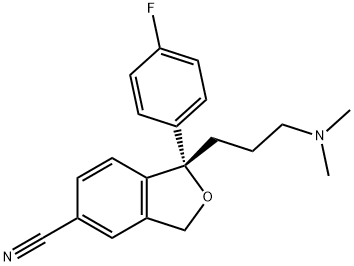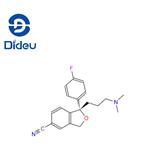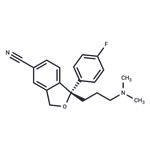(S)-Citalopram is an inhibitor of serotonin (5-HT) uptake. Antidepressant.
antidepressive;selective serotonin reuptake inhibitor
ChEBI: A 1-[3-(dimethylamino)propyl]-1-(4-fluorophenyl)-1,3-dihydro-2-benzofuran-5-carbonitrile that has S-configuration at the chiral centre. It is the active enantiomer of citalopram.
escitalopram (lexapro,cipralex)is a selective inihibitor of serotonin(5-ht) reuptake (ssri) with a ki value of 6.6nm for [3h]-5-ht uptake [1].escitalopram is the s-(+)-enantiomer of citalopram and has the inhibition of [3h]-5-ht uptake and [125i]-rti-55 binding in cos-1 cells expressing the human serotonin transporter (5-htt) with ki values of 6.6±1.4nm and 3.9±2.2nm, respectively. in addition, escitalopram has been reported to inhibit the accumulation of 3h-labelled monoamines into rat brain synaptosomes in vitro with ic50 values of 2.1±0.75nm, 2500±202nm and 40000±15500nm for [3h]-5-ht, [3h]-i-na and [3h]-da, respectively. apart from these, escitalopram has shown the in vitro affinity for rat histamine h1 receptors and the rat sigma σ1 site with ki values of 1500±780nm and 100±71nm, respectively [1].
Escitalopram is the S-enantiomer of citalopram that binds with high affinity and selectivity to the human SERT
equivalent to (±)-citalopram. It has been reported that nearly all the activity resides in the S-enantiomer and
that R-citalopram actually counteracts the action of the S-enantiomer. Studies show that escitalopram
exhibits twice the activity of citalopram and is at least 27 times more potent than the R-enantiomer. The
R-enantiomer inhibits the S-enantiomer at the transporter. Escitalopram's mechanism of action is
common to the SSRIs.
The pharmacokinetics for escitalopram does not exhibit stereoisomer selectivity and, therefore, is similar to
that for citalopram. Likewise, it exhibits linear pharmacokinetics so that plasma levels increase
proportionately and predictably with increased doses, and its half-life of 27 to 32 hours is consistent with
once-daily dosing. It also has been found that R-citalopram is cleared more slowly than the S-enantiomer.
Therefore, when the drug is used as a racemic mixture (citalopram), the inactive isomer predominates at
steady state. This is an added incentive for use of the enantiomerically pure escitalopram. Escitalopram has
negligible effects on CYP isoforms, suggesting a low potential for drug–drug interactions. Escitalopram is indicated for patients with major depressive disorder, generalized anxiety disorder, panic disorder, and social
anxiety disorder.
SSRI antidepressant:
Depressive illness
Panic and social anxiety disorder
Potentially hazardous interactions with other drugsAnalgesics: increased risk of bleeding with aspirin
and NSAIDs; risk of CNS toxicity increased with
tramadol.Anti-arrhythmics: increased risk of ventricular
arrhythmias with amiodarone, disopyramide and
dronedarone - avoid.Antibacterials: increased risk of ventricular
arrhythmias with IV erythromycin, moxifloxacin,
pentamidine and telithromycin.Anticoagulants: effect of coumarins possibly
enhanced; possibly increased risk of bleeding with
dabigatran.Antidepressants: avoid concomitant use with MAOI,
increased risk of toxicity; increased risk of CNS
toxicity with moclobemide - avoid concomitant use;
avoid concomitant use with St John’s wort; possibly
enhanced serotonergic effects with dapoxetine
and duloxetine; can increase concentration of
tricyclics; increased agitation and nausea with
tryptophan; increased risk of CNS toxicity with
rasagiline; possible increased risk of convulsions with
vortioxetineAntiepileptics: convulsive threshold lowered.Antihistamines: increased risk of ventricular
arrhythmias with mizolastine - avoid.Antimalarials: avoid concomitant use with
artemether/lumefantrine and piperaquine with
artenimol; possible increased risk of ventricular
arrhythmias with chloroquine and quinine.Antipsychotics: possibly increased risk of ventricular
arrhythmias with haloperidol, phenothiazines and
pimozide - avoid.Antivirals: concentration possibly increased by
ritonavir.Beta-blockers: increased risk of ventricular
arrhythmias with sotalol - avoid.Dopaminergics: avoid with selegiline; increased risk
of CNS toxicity with rasagiline.5HT1
agonist: increased risk of CNS toxicity with
sumatriptan; possibly increased risk of serotonergic
effects with naratriptan.Linezolid: use with care, possibly increased risk of
side effects.Lithium: increased risk of CNS effectsMethylthioninium: risk of CNS toxicity - avoid if
possible.
Escitalopram is metabolised in the liver to the
demethylated and didemethylated metabolites. Both
of these are pharmacologically active. Alternatively,
the nitrogen may be oxidised to form the N-oxide
metabolite. Both parent substance and metabolites are
partly excreted as glucuronides. After multiple dosing
the mean concentrations of the demethyl and didemethyl
metabolites are usually 28-31% and <5%, respectively,
of the escitalopram concentration. Biotransformation of
escitalopram to the demethylated metabolite is mediated
primarily by CYP2C19. Some contribution by the
enzymes CYP3A4 and CYP2D6 is possible. The major
metabolites have a significantly longer half-life than the
parent drug.Escitalopram and major metabolites are assumed to be
eliminated by both hepatic and renal routes, with the
major part of the dose excreted as metabolites in the
urine.
[1] sánchez c1, bergqvist pb, brennum lt, gupta s, hogg s, larsen a, wiborg o. escitalopram, the s-(+)-enantiomer of citalopram, is a selective serotonin reuptake inhibitor with potent effects in animal models predictive of antidepressant and anxiolytic activities. psychopharmacology (berl). 2003 jun;167(4):353-62. epub 2003 apr 26.



